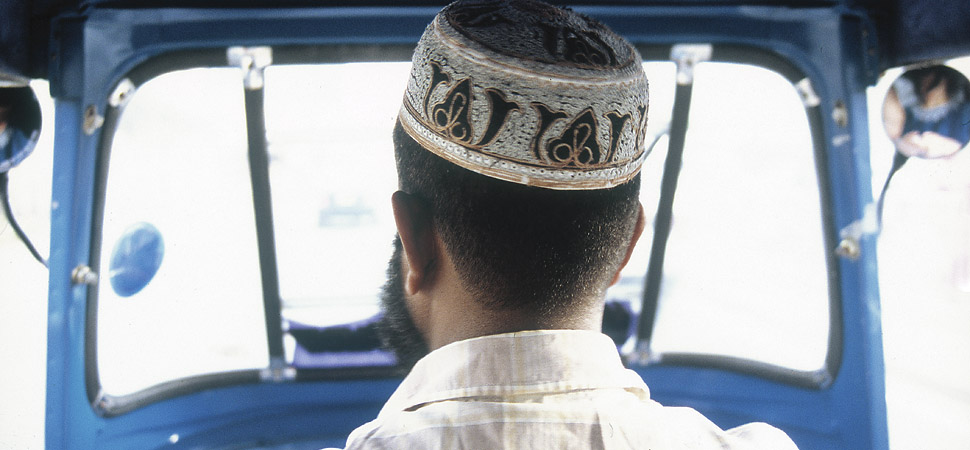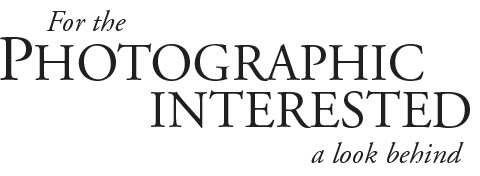
I like the smell of film and I like well-designed equipment. And I like to know other photographer's tricks and workflow. So I thought I would spend a few minutes for those of you who likewise have that interest.
With me to South East Asia I had five of my nine Leica cameras. I mainly used three cameras at the time: The fully manual Leica M4 around my neck (mostly with the 21 mm Leica Super-Angulon-M f/3.4 lens on it for shots like the one at page 24 and in general where I moved in close).
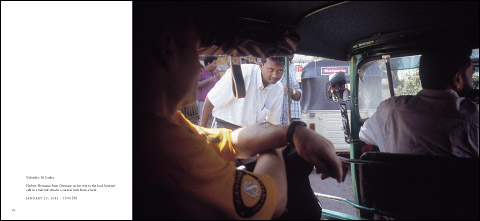
Page 24-25
On one shoulder I then had my Leica R8 with motordrive, mounted with the 80mm Summilux-R f/1.4 that I used for 80% of my shots in South East Asia. Those who know this particular lens know that it is a deadly choice because it has such a narrow tolerance of sharpness. But when it works, you get three dimensional pictures with selective focus as the one on page 63. Using that lens at f/1.4 to f/5.6 is fun and creates a feel that is both dreamlike but also very much the way the eye works with selective focus; you have a wide angle view as a 35mm lens but really you focus only on a selective part of the scenery. For me, the 80mm produces that exact look.
On the Leica R8 and Leica SL MOT I alternated with 35-70mm Vario-Elmar-R f/4.0, 35mm Elmarit-R f/2.8 and 90mm Summicron-R f/2.0. The 90mm I would use where I needed to be sure the shot was sharp but where I wanted an effect much similar as the 80mm.
Some would argue, the Leica SL MOT should never have been on such a dusty and dangerous travel. Only 862 were made in black and mine had just come back from Leica in Germany after a general checkup, cleaning, lubrication and had gotten new top and bottom plates so it literally looked like a brand-new camera - even 32 years old. No doubt amongst the most well-preserved Leicas of its kind on the planet. However, I'm not a collector of cameras but a user of them. So the rare SL MOT came with me and it did get in a few bumps. But it is a lovely camera to use and it has the most sexy shutter sound any camera ever had.
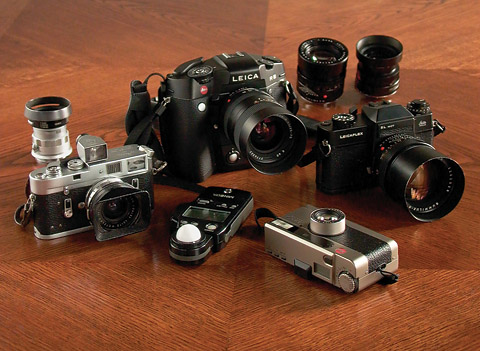
The equipment I brought with me: Leica M4 with 21 mm Super-Anuglon-M f/3.4 and 50mm Summicron-M f/2.0, a Minolta Flashmeter IV (used for measuring light manually), Leica R8 with motor drive and 35-70mm Vario-Elmar-R f/4.0 and the Leicaflex SLmot with 80mm Summilux-R f/1.4 and the 35mm Elmarit-R f/2.8 and 90mm Summicron-R f/2.0. Finally the Leica Minilux with buitd in silent winder and 40mm Summicron f/2.8 autofocus lens. A camera I recommend to all my friends who would like to start photography. Most of the stuff is described in details at http://leica.overgaard.dk
Lighmeter
 I like to measure the light hitting the subjects rather than having the camera measure the light reflecting the subject (to rely on reflection light you have to measure the light reflecting from a neutral gray surface). So I used the Minolta Flashmeter IV for 95% of the shots. Usually I would measure the light in every 20 minutes and go from there. The Leica R8 has a very precise build in light meter which I used when there was no time for measuring light manually. I like to measure the light hitting the subjects rather than having the camera measure the light reflecting the subject (to rely on reflection light you have to measure the light reflecting from a neutral gray surface). So I used the Minolta Flashmeter IV for 95% of the shots. Usually I would measure the light in every 20 minutes and go from there. The Leica R8 has a very precise build in light meter which I used when there was no time for measuring light manually.
Slide film
I love Fuji Astia 100 ISO slidefilm because it gives very "Scandinavian" cool and natural colors. For this project I used a variety of other films as well because I had to buy stocks in India. It was really rare to find slide films and most of the rolls had to be shipped from other towns near to where I was.
Quite many of the films - I calculated - has been through 24 x-ray machines all together. That together with the heat and in many cases, almost due last sales date on the film, made it unsure what the result would look like. When I had to, I squeezed the 100 ISO films to 400, 800 or 1600 ISO. The picture of His Holiness on page 112-113 in the book is Fuji Astia 100 ISO as 1600 ISO, handheld at 1/15 second (It's the moon behind him and the light on his face is a reflection from some distant lamp):
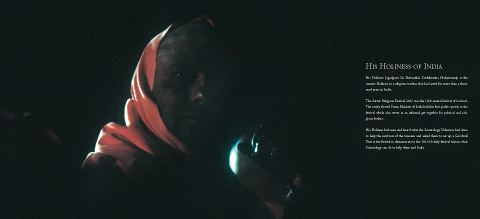
Page 112-113: A quite impossible shot of His Holinesss of India: 1/15 second handheld, 100 ISO Fuji Astia slide film run as 1600 ISO. It looks great as a 20' wide spread in a book.
Scanning
I used an Imacon Flextight Photo scanner as well as a Nikon Coolscan IV to have two scanners working simultaneously. I ended up using the Imacon for most of the work and only the Nikon Coolscan for about 15% of the shots that ended up in this book.
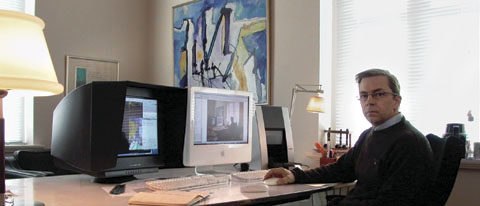
The Leica Minilux point and shoot camera I had as reserve and only shot two rolls with it. The 40mm lens on it is world famous and one could have taken that camera alone and done a fantastic series without anybody even noticing one taking pictures. Even though it has a motorized drive, it is so silent nobody ever noticed it. However, 40mm wasn't the range I wanted to work with for this trip. It's good for street photography and discrete photographing indoors in museums and cafés.
Working
The way I would usually work was that I would stay in the outer perimeter of an event. Of the thousands of digital pictures taken in South East Asia by others where I was present, I'm only in five of those pictures; that's how distant I worked. I might have only been few meters behind the scene at most of the time but that is usually enough not to get noticed.

I would stay rather inactive in the beginning of an event. Usually a crowd of people will shoot their digital cameras in the beginning, often moving real close to the subject. I would mostly use the 80mm or 90mm to narrow in on the event from a distance why I had to wait for things to calm down before I could get some clear and natural shots.
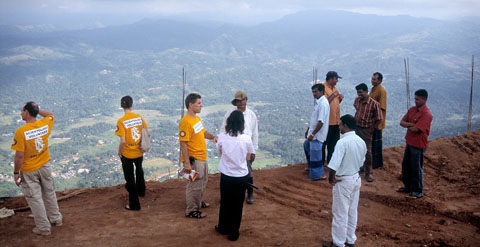
The thing is also that the best shots are to be gotten by the end of an event. At that point you are familiar with who's who, what the story is, you have had time to consider what the opportunities are in the event, and the people present feel comfortable with you and each other.
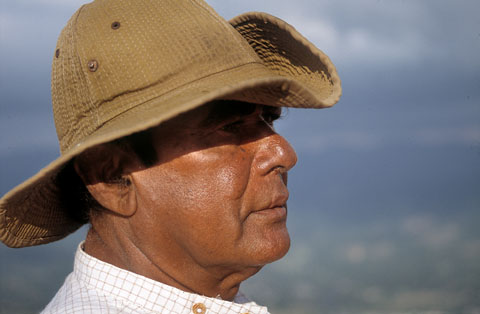
The minister of transport, Sri Lanka.
With the kids in the Sri Lankan Sunday school (page 44-47) I had trouble staying unnoticed even if I just hung around for half an hour without using the camera. When I finally started, hell broke loose; but then we had fun and made some funny pictures of each other (those are not in the book but I exchanged addresses with some of the kids so I could send them).
Digital photography
The Leica Digilux 1 I only used very little for private shots to send home via e-mail to my wife and three kids. I had hoped to get the new digital back for the Leica R8 with me but it wasn't released yet when I went.
Traveling
Even though my equipment added up to about 20 kilos of cameras, it was not a problem. Usually, I was able to store the cameras I was not using in a building or a van. My photo bag was a very discrete $30 black photo bag with no symbols and logos that would literally say "this bag does not exist" whenever I dropped it in a corner. I also had a backpack with an 12" Apple iBook laptop and cables and card readers for the volunteer's cameras, plus shirts and stuff for several days of travel at the time (I never knew when I would meet my suitcase again, which was parked in Colombo in Sri Lanka).
Pockets
My trousers - believe it or not - was an important part. It's Swedish made Fjällräven which can last for ten years of use and has seven pockets. Besides money, cigarettes, film rolls and the flashmeter I used the pockets for pens and notebooks; one large notebook for journalistic notes and a small black one for notes on the photos.
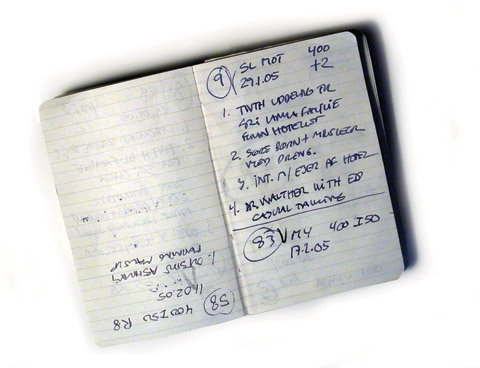
The Moleskine pocket book
Admin
Each roll of film I would mark with a number when loading it in the camera. Then in the small black notebook I would note that number, the date and what ISO and camera I used. For each roll I would note names of people and events in an approximate sequence as it had happened. After a roll was shot I would mark it as done in the book and put the roll into a cylinder I would likewise mark with that number. The lab home in Copenhagen developed it all in three hours and was able to maintain the numbering which made the work very easy when I sat down and had to put data into the picture files.
Archiving
For archiving I used iView MediaPro which is a quite fast and handy database for picture files and - actually - also sound files, PDF files, etc. The main thing about it is that it doesn't archive the actual picture file but create a small preview and keep track of the original file, which in my case lay on external LaCie Firewire drives.
Inside iView Media Pro I would organize each roll in a numbered folder referring to the actual roll number and the corresponding notes in my notebook. Thus I had a clear overview of what was there and the keywords, texts, etc attached to each picture file.
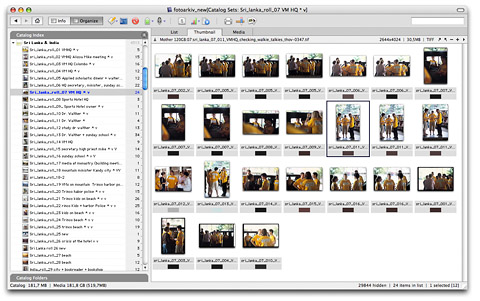
iViewMedia Pro folders and previews. Drag and drop...
In doing the DVD and slideshows I could simply create a new folder for each slideshow and drag the picture files to that folder, arranging sequences and even run a test slideshow with soundtrack and all (the large QuickTime slideshows available from the website is actually exported directly out of iView Media Pro).
What to shoot
Being there and being observant you will soon start anticipating the photo opportunities that are likely to occur; you see the events that are going to happen and you figure out where you have to be in 40 seconds to capture it in the way you envision. I obviously needed to have lots of photos of volunteers in "uniform" (the yellow t-shirt) working. If some had forgotten to wear t-shirts I had to make sure they put a t-shirt on because in a picture they would just look like an ordinary civilian and nobody could tell who was who. The t-shirt makes it very easy. This of course also ruled out taking black & white photos. Then I was looking for aesthetic shots which for me are mostly of people. I don't take photos of dead objects like forlorn tree stumps no matter how interesting it looks. There has to be life in pictures and that means people.
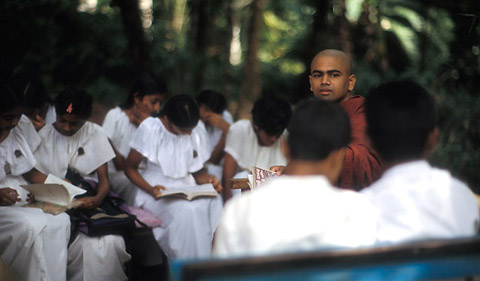
People means life. And the more they look through
the camera and at the audience, the better.
I shot for numerous things and purposes. The overall purpose was documenting which meant taking pictures of everything that happened. For the book the editing rule mainly was "if it doesn't have a photographic value and/or an important value as a testimony of what the volunteers did, it's not part of this book." This way many interesting pictures went out, simply because those pictures would only be interesting to those of us who was part of the events or some other limited audience. A photo can have great value for few people even it is not technically or aesthetically great. But not for a book like this. My friend and award-winning graphic book designer Claus Due helped me getting rid of the doubles and a lot of lovely pictures that was just "too many pictures." It was painful.
For the DVD and slideshows quite a few more shots from each series could be added to keep a storytelling-flow. And thus many photos of less photographic value was included there. The tools
The Leica M4 and the other M cameras are great cameras in the way they are precise, sturdy and simple. The only thing a Leica M4 does when you press the shutter is say "click" in a very silent way. There is no moving mirrors, no moving motors. Just a simple click - and you have a picture. That way you as a photographer aren't separated from the subject by a lot of sophisticated stuff. It's just you and the subject basically, which does make some different pictures than if you bring a fully automatic motorized picture-machine like most press photographers do these days. Also, one should not forget, the surroundings you are there to photograph react differently to large professional looking equipment than a small, amateur-looking Leica M camera. In most peoples eyes it looks like your grandpa's camera you borrowed (which it almost is because the M model haven't changed that much since it came out in 1925). In many ways it feels like painting. It feels slow, thoughtful and you have no help remedies but your imagination and talent.
The Leica SL MOT was the first SLR (Single Lens Reflex camera) Leica made and it has the feel of an M camera, but with the facilities of "modern" cameras where you see through the lens and see the exact picture. Besides that, though, it has nothing automatic to offer (which I state with enthusiasm).
The Leica R8 is fully automatic and fast. It is a picture machine. However, it does not have autofocus. That, along with using manual light metering, brings down the photography process to a tempo where you have time to reflect, think and compose.
I hope this was helpful and informing. Any questions or comments are welcome. Feel free to e-mail me – I shall try my best to answer you back. thorsten@overgaard.dk
|

